THE
SOUND OF BAMBOO
Blowing Zen & The Spirit of Shakuhachi
Bob Berlin-Grous & Monty H. Levenson
with
Clifton Karhu & Taniguchi Ryudo Yoshinobu
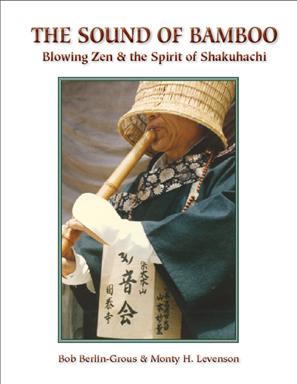
|
THE
SOUND OF BAMBOO Bob Berlin-Grous & Monty H. Levenson
|
|
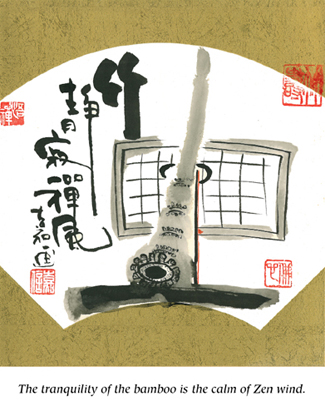
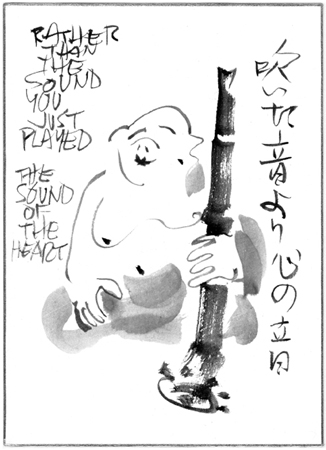
|
This book is a virtual encyclopedia of shakuhachi with enhancements The Sound of Bamboo provides an expansive overview of the shakuhachi, a traditional Japanese bamboo flute dating back to the 7th Century, and its close association with Zen Buddhism as a vehicle for meditation.he first section of the book, Shakuhachi: A Journey of Discovery, was written by Bob Berlin-Grous over four decades ago, between 1974 and 1980, when he studied shakuhachi koden and koten honkyoku with the renowned teacher Sato Seibi, and Zen Buddhist philosophy with Abe Masao. Originally published in 2013, this revised edition has been greatly expanded, updated, and edited by Monty Levenson in the new 2019 interactive edition. Bob's comprehensive work is far more than a personal narrative. It is a thoroughly-researched treatise providing a complete overview of shakuhachi in its relationship to Japanese culture and foundation in Zen Buddhism. The initial part starts out with a description of the craft of the shakuhachi, exploring every aspect of how the instrument is traditionally made by craftsmen in Japan. Each step in the process is carefully documented. Selection and harvesting of madaké bamboo in the grove is followed by information detailing all aspects of the traditional craft. Chapter 2 explores the Japanese sense of sound, describing the unique acoustical sensibilities deeply embedded in Japanese culture, language and physiology. Bob explains how the shakuhachi's tonal variability and association with nature embodies nuanced ways of perceiving the world, making is a perfect vehicle for spiritual practice and aesthetic expression. A review of the historical evolution of the instrument and its traditional music is followed with a detailed analysis of shakuhachi honkyoku from both a Western analytical and Japanese perspectives on music theory. The piece Hi Fu Mi Cho is analyzed phrase-by-phrase in order to shed light on the structure and tonal phrasing of honkyoku music. Other more contemporary forms of Japanese music such as Gaikyoku, Juita and Shinkyoku or New Music are also covered in this chapter. The final chapter presents an exhaustive discussion of the religious foundations of shakuhachi and honkyoku music and their association with Zen Buddhism in the hands of Komuso priests of the Fuke tradition. Included in the book are beautiful and inspiring Zen- and shakuhachi-themed Japanese sumi-e ink brush paintings by two renowned artists—Clifton Karhu and Taniguchi Ryudo Yoshinobu—published for the very first time in this edition. The final section, Stalking the Wild Bore, Monty Levenson expands and broadens his analysis of the acoustical physics of the shakuhachi—an effort to unravel the mystery of how breath is transformed into its remarkably resonant and nuanced sound. The Sound of Bamboo is made possible by the encouragement extended by Ricoh USA, Inc. and Ricoh Company Ltd. of Japan with support by the Graphic Communication Institute at Cal Poly State University in San Luis Obispo, California. This edition is something entirely new and different in how information is transmitted, imparted, and otherwise conveyed. Embedded in pages of the book is a fourth section composed of hyperlinks that open a portal to the wide and wonderful world of shakuhachi. Access to this deep repository of information is provided via interactive web links, audio music files, and multimedia video content. The links introduce you to many of the foremost shakuhachi players and master teachers in Japan and around the world, sharing with readers their invaluable, diverse, and unique perspectives, and gracing you with performances of their deeply moving music. Unlike any other printed book, content and enhancements are continually being added, so The Sound of Bamboo will never become outdated. In this way, a “Japanese experience” is brought to life through music, culture, learning, and training via web pages, videos, and sound. A printed book or other form of print media can now be embedded with multiple hotspots linked to one or multiple sources, thereby taking readers from two-dimensional printed content to online, multi-channel content.The beauty of this new interactive technology goes beyond broadening the informational parameters of a printed book. It also allows an edition to be expanded and enhanced past the date of its initial publication. Like any online website, linked content can and will be updated or otherwise modified well into the future, keeping a book relevant and up to date. And finally, it encourages interaction amongst readers, authors, and others by opening channels of communication within a community of interest. Encyclopedic in scope, The Sound of Bamboo includes over 100 photos, illustrations, and artwork as well as 400 hyperlinks connecting the reader from the printed page directly to the world of shakuhachi via the Internet. Revised 2nd Edition. 174 pages PG-24
|
|||||
THE SOUND OF BAMBOO: Blowing Zen & the Spirit of Shakuhachi Preface Introduction: Chapter 1: Chapter 2: Chapter 3: Notes About the Author & Artist SHAKUHACHI SUMI-E STALKING THE WILD BORE: A Trek into the Heart of Shakuhachi Darkness Introduction New Technologies for Shakuhachi Making Notes About the Author |
||||||
Some Photos & Images from The Sound of Bamboo
|
|---|
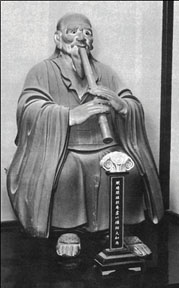 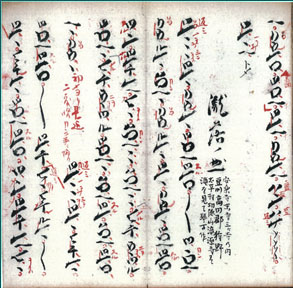 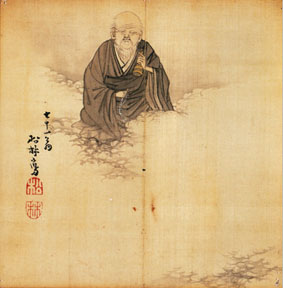 |
 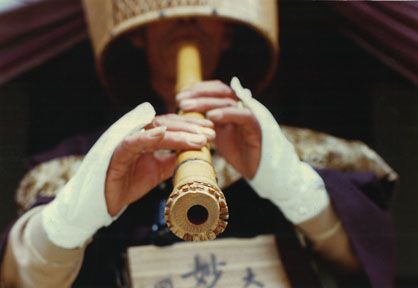 |
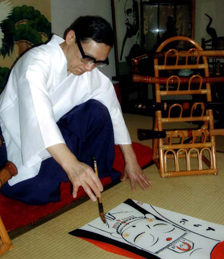 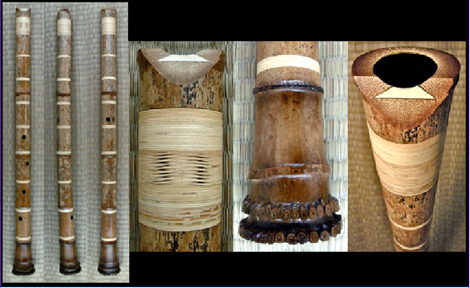 |
Bob Berlin-Grous acquired his first shakuhachi in Kobe, Japan and began blowing in earnest upon his return to northern California. Soon after being introduced to the traditional music, he moved to Los Angeles to study shakuhachi with Baido Wakita. After a year and a half, Wakita sensei recommended that he go back to Japan to deepen his studies. From 1974 to 1980 Bob studied Kinko honkyoku with Sato Seibi in Osaka. Today he continues to blow shakuhachi at his home in Santa Rosa, California. Bob is the author of Introductory Manual for Kinko Honkyoku and a CD entitled Karhu. |
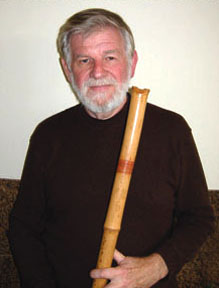 |
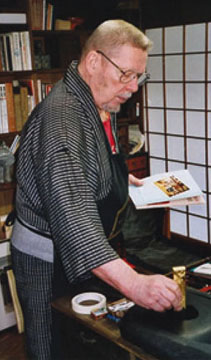 |
Clifton Karhu, who was of Finnish descent, was born in Duluth, Minnesota, USA, in 1927. Between 1946-48 he was stationed in Sasebo, an American Navy base in Japan. From 1950-1952 he studied and graduated at the Minneapolis School of Art. He returned to Japan as a missionary for the Lutheran church, selling Bibles door to door, but around 1958 he started his artistic career in Japan. First he made oil paintings and watercolors while living in the Gifu area. In the early 1960s he concentrated on making mokuhan, woodblock prints. In 1963 he moved to Kyoto, and in 1964 he became a member of the Nihon Hanga Kyokai. From the start his work was popular, and eventually he became one of the grand old men of Sosaku Hanga. Karhu's work is instantly recognizable because of its strong forms, lines and colors. He did his own carving and printing, and continued doing so until the very end of his life. Clifton Karhu was a resident of Kyoto for more than 40 years. He died in Kanazawa on March 24th 2007, and was buried in Kyoto, in Gion, which he loved most of all, and where he was often seen sketching.
|
Taniguchi Ryudo Yoshinobu is one of the foremost living masters of shakuhachi in Japan today. In addition to having studied under three great pillars of shakuhachi—Aoki Reibo, Yamaguchi Goro, and Yokoyama Katsuya—he has also mastered the playing styles and repertoire of many other shakuhachi sects. Taniguchi is a recipient of the transmission of Koden Honkyoku through Watazumido Shuso and Yokoyama Katsuya. |
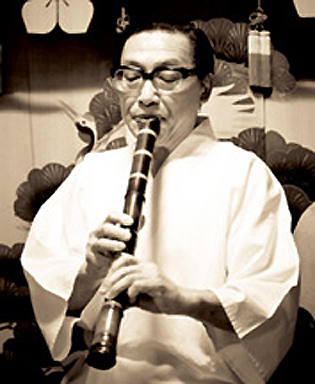 |
 |
Tai Hei Shakuhachi are made by Monty H. Levenson who maintains workshops at his home in the hills of Mendocino County, California, as well as in Japan at the small farming village of Kitagawa (Tokushima Prefecture) on Shikoku Island. Monty has been making shakuhachi since 1970. |
|
この度の作品”The Sound of Bamboo”は、いかに多くの時間を費やして編集されたかを考えると、驚くべき力作であることは、誰もが認めると信じます。Montyさんの著述や編集は想像を越える日々を費やしておられ、今までの実績として、こういう形で残ることは尺八界にとっての偉業でもあります。心から敬意を表します。 I believe that everybody reading The Sound of Bamboo would agree that it is a remarkable achievement. The extensive amount of time and energy it took to conceive, design, edit, and layout this interactive edition is clearly evident. The book is an invaluable resource for all members of the world shakuhachi community. The great effort it took to produce is something I personally appreciate and respect very much. Clickable Print技術を駆使されて、知りたい方の情報のみならず、演奏まで見たり、聞いたりできることは、正に現代のIT技術を効果的に活かされており、画期的な作業です。 The innovative Clickable Print technology is truly groundbreaking in that goes way beyond traditional books by providing information in a many different forms. The effective use of this modern IT technology was developed in a long collaboration by Ricoh Japan and USA. It links the printed word to a wide variety of multimedia content on the Internet via hyperlinks embedded in the book. A vast amount of research went into creating this publication. It is a great resource for shakuhachi players and enthusiasts with which I am very impressed. 尺八音楽を作曲される多くの作曲家や、それを演奏する尺八家は、いかに聴衆や観客に感動を与え得るかを作品に心を籠めておられます。この度のMontyさんの作品も正に、各所に配慮をされた偉大な作品だと確信しております。それは、大切な竹の素材を、人々に喜んでいただける尺八という作品を誠意を籠めて製作されておられるMontyさんの全身からの発露であると感じています。 Shakuhachi composers and players endeavor to provide the listening audience with a wide range of deep emotions and passion conveyed through their music. I believe this book truly had the same spirit motivating its creation. It comes from a sincere intention as that of a shakuhachi maker using raw natural bamboos to create a unique musical instrument that people love and appreciate. I can feel this intentionality throughout the pages of this book. I have been playing the Western silver flute since high school, and began studying shakuhachi at the age of 29. This transition led me to the Shakulute, a hybrid instrument incorporating both types of flutes. For myself, this was clearly a case of West meets East. I want to express my sincere appreciation for being featured as a Shakulute player in The Sound of Bamboo. Kozan Tanifuji The Sound Of Bamboo--Blowing Zen and the Spirit of Shakuhachi offers an exciting and wonderful new pathway into the culture, history, and music of this remarkable bamboo flute. When I began my own shakuhachi journey in the late 1960s, there was virtually no written material in the English language about the shakuhachi, save a couple of journal entries. Through the 1970s and beyond, as more people outside of Japan began to study and appreciate shakuhachi music, the instrument gradually became part of our globalized musical world and numerous articles, books, and recordings appeared internationally. Now we are treated to this stimulating new resource. Bob Berlin-Grous’ thorough and articulate overview of the shakuhachi ethos and Monty Levenson’s updated insights into the spirit of bamboo and instrument making come together to create a most welcome and refreshing understanding of “the shakuhachi life”. But wait, there is much more! The new Ricoh clickable print technology transforms what would be a mere book into an animated, ever-evolving interactive source of expansive knowledge and information. I really enjoy it and look forward to watching it grow over time. Ralph Samuelson As players of the shakuhachi, most of us have a deep interest and respect for how the instrument arrived into the 21st century through hundreds of years of history and evolution. The Sound of Bamboo, incorporating Ricoh's Clickable Paper technology, is not only a book, but a living document that mirrors the necessarily ever-changing nature of the instrument. The two sections of this text by Berlin-Grous and Levenson are excellent resources for pulling together all aspects of what it means to practice the shakuhachi. The first section contains moments of intellectual and contemplative density that allow for reflection and discovery through multiple reads. The second section is an indispensable resource for orienting makers and players toward techniques and questions emerging from decades of expert experience in constructing instruments. It highly international in scope and unafraid of forward-thinking use of materials and technology. The book is ultimately, though, about the art and practice of the shakuhachi as underscored by the extraordinary calligraphic/visual works by Karhu and Taniguchi woven into the text. It is a must have for all players and enthusiasts of the instrument, if anything because it allows itself to evolve, just like the instrument has over centuries. Kojiro Umezaki The Sound of Bamboo, utilizing ground-breaking technology, is an essential reference for all things shakuhachi. When I started out on the path of bamboo, I searched high and low for anything and everything on the subject. All I could find were some bits and pieces. Now, we have it all in one place. The book is a marvel, so well-written and documented, one could spend a lifetime capturing its essence, as its authors have obviously done. A unique aspect of this volume is Ricoh's innovative Clickable Paper technology. I am not a big fan of e-books. I’m old school in that I love the feel, look, smell of paper. It has substance and no batteries are required. That said, the inclusion of internet search technology helps link us to key sites and resources to further our understanding of the subject at hand. It might prove to be indispensable in the future. I cannot recommend The Sound of Bamboo enough. It is truly a godsend. Barry Daido Houun Weiss In putting together the material for their interactive book The Sound of Bamboo, Monty Levenson and Bob Berlin-Grous have created a tremendous resource for all of us who share an interest in the shakuhachi. This book is the product of many combined years of experience in playing, teaching, making and ultimately, thoroughly understanding the shakuhachi and its music. The contents of the book are well-organized, and the text is very well written. Moreover, owing to the prodigious on-line links included on virtually every page of the book, it becomes a multimedia storehouse of musical examples, visual art and illustration, written history, biographical information, and so much more. In buying this book you are really buying a thoughtful and comprehensive encyclopedia of all things shakuhachi. I am grateful to the authors for the work they were willing to do to share their combined knowledge and experience with us. Patrick Genchoku Johnson The Sound of Bamboo is a remarkable achievement and very welcome resource for anyone interested in the shakuhachi, and entertaining as well. With great photos, music examples, wonderful sumi-e brush paintings, and with interactive “Clickable Paper” (thanks to Ricoh Company) to expand information on individual points of interest. An enormous amount of information is covered. Monty Levenson is a very articulate writer and uniquely positioned as a shakuhachi maker/player to address many of the “where-does-that-amazing-sound-come-from?” questions that occur to anyone who has heard (or tried to play!) this extraordinary traditional Japanese bamboo flute. John Kaizan Neptune The Sound of Bamboo is a wonderful resource for all things Shakuhachi. The strength of the work lies in the wholeness of it: one sees the instrument in all its facets, richly contextualized. Here you can find sections on the history of the instrument, its repertoire both ancient and modern, the sound in all its subtlety, construction methods both traditional and contemporary … all made fully three-dimensional by a thoroughgoing immersion in a Japanese cultural context and Zen philosophical context, a sensitivity to the nuance of sound, and an awareness of how the bamboo elicits a reverence for its origins in nature. All this comes about through the authors’ and editors’ diligence in finding and referencing the most telling touch points, made possible through the multidimensionality of the Clickable Paper platform, putting a variety of media and avenues further exploration at your fingertips. Bart Hopkin i have lived almost half of a century in a monastery, but i am not a monk. Rather, the 'monastery' is actually a correctional facility that is part of the Federal Bureau of Prisons where i have been an inmate since 1973. Veronza Bowers, Jr. It would be a mistake to think of this as just a book. In reality, it is an entire library about every aspect of the shakuhachi. Through the magic of Ricoh's Clickable Paper technology, almost every page has curated links to a variety of content. When you read about a piece of music on the page, the clickable paper app will let you immediately go to a YouTube video of someone playing that music. Or an article on lacquer. Or Japanese history. Or a temple you're reading about. The Clickable Paper is not the clumsy QR codes that take up space on the page and impact the book's appearance. This technology is invisible. All you need to do is aim your smartphone or tablet at the page, and the links are there for you to click. It will take me years to get through this book, and I'm looking forward to every page! Bruce Alter The Sound of Bamboo is incredible—insightful in so many ways and spiritual in its vibration. Regarding the new technology—Clickable Print Technology—I think it's amazing! I admit to being something of a geek, growing up on Star Trek and the like, utilizing the book in that manner is like arriving in the future via some incredible device. For me, it is the way all books on music and culture should be produced. For example, a book on shakuhachi can be incredible well-written, informative and intriguing (as is yours), but one might consider it incomplete without hearing the sound of instrument and seeing those devoted to its practice. Whereas as separate CD or DVD might prove to be a decent addendum, it's much more immediate and effective to be able to point at the page as you read it and immediately be taken to a world which amplifies the subject in the moment with additional text, sights and sound. The book becomes a true medium for transportation to a different place. I am new to shakuhachi, but a lifelong musician and a classically-trained vocalist. This book and the wealth of internet-linked resources that come with it are overflowing with great stories, history, physics, art (beautiful images!), culture, music, and sound. As a new and eager "player," I am so glad and feel just plain lucky to be learning from The Sound of Bamboo. I will be for a long time —a resource that will last (and get updates online!). Kyle Curley The Sound of Bamboo is a compendium for all things shakuhachi. Finally there is one place to go to learn the vast history, mythology, philosophy, spiritual, and technical aspects of the mystical bamboo flute. Complete with beautiful artwork and hyperlinks for the digital age, Bob Berlin-Grous & Monty Levenson have written the perfect book for shakuhachi and world music enthusiasts. Adam Wells I have not finished reading The Sound of Bamboo, but what I have I love. It's like a never ending book. Being able to access sound clips and extra material is awesome. Makes it so much easier than constantly trying to research. This is a new experience for me and I do love it . Thank you, I think it is quite brilliant.
Gassho. So far, I got about a third of the way through the The Sound of Bamboo and love it. I have to say that Chapter 2: The Culture: The Japanese sense of sound was the best article I've ever read on the subject and goes far beyond merely shakuhachi. Bob Sedivy You did a great job, Monty. Worth the wait. The Clickable Print works great making the book much more content heavy, and slower to work through, so I haven’t finished it yet. But what I have read to date I like very much. Thanks for the link to the updates. It’s like the book that keeps on giving. Cool! David Kent I have been enjoying reading The Sound of Bamboo. I find the Clickable Paper technology to be a fascinating approach to the issue of re-prints and re-issuing of materials. The post-publication updates are great. I really like the book and am glad to have a copy of it. I have been enjoying The Sound of Bamboo book. Tons of information. I love the artwork. The Clickable app is working just fine. It's great to have both a physical book to work with, and the mass of information on the internet. The book really is a leap forward by mixing print and internet. Good mix! More people should have it. Nancy Mullin I am thoroughly enjoying The Sound of Bamboo. The book stands fully on it’s own, even without the Clickable Print technology. However, Ricoh's innovative app linking the printed page directly to the internet in a matter of seconds complements the text with an amazing wealth of related musical, cultural, and historical information. Indeed, this is a book that not only reads well, but sings and dances! I find this combining of opposites—21st century technology with the ancient Zen shakuhachi tradition—most remarkable and informative, to say the least. Ricoh’s high-tech, user-friendly CP app, paired with the shakuhachi’s low tech and high challenge to the user (to this writer at least) yields a wonderfully rich experience every time I pick up this book. With hundreds of hyperlinks augmenting the text reminds me of the continued surprises and discoveries that come with learning to blow the shakuhachi; one is never quite certain what sounds may emerge. A deep bow of appreciation. Don Boone
|
| Price of Book | Ordering Information |